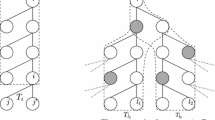Abstract
We study simple algorithms for the balanced MAX 2SAT problem, where we are given weighted clauses of length one and two with the property that for each variable x the total weight of clauses that x appears in equals the total weight of clauses for \(\overline{x}\). We show that such instances have a simple structural property in that any optimal solution can satisfy at most the total weight of the clauses minus half the total weight of the unit clauses. Using this property and a novel analysis of the computation tree, we are able to show that a large class of greedy algorithms, including Johnson’s algorithm, gives a \(\frac{3}{4}\)-approximation algorithm for balanced MAX 2SAT; a similar statement is false for general MAX 2SAT instances. We further give a spectral 0.81-approximation algorithm for balanced MAX E2SAT instances (in which each clause has exactly 2 literals) by a reduction to a spectral algorithm of Trevisan for the maximum colored cut problem. We provide experimental results showing that this spectral algorithm performs well and is slightly better than Johnson’s algorithm and the Goemans–Williamson semidefinite programming algorithm on balanced MAX E2SAT instances.

Similar content being viewed by others
Notes
Although Khot et al. state their guarantee for balanced MAX 2SAT, their argument (in the proof of Theorem 3 in [10, p. 340]) implicitly assumes that no clauses of length one are present. Only then the observation that “linear terms cancel out” in the arithmetization is valid, a fact that we also utilize (see Sect. 4).
References
Argelich, J., Li, C.M., Manyà, F., Planes, J.: MAX-SAT 2014: Ninth Max-SAT evaluation. www.maxsat.udl.cat/14/. Accessed on 13 June 2015
Austrin, P.: Towards sharp inapproximability for any 2-CSP. SIAM J. Comput. 39(6), 2430–2463 (2010)
Belov, A., Diepold, D., Heule, M.J., Järvisalo, M.: Proceedings of SAT Competition 2014: Solver and Benchmark Descriptions (2014)
Buchbinder, N., Feldman, M., Naor, J., Schwartz, R.: A tight linear time (1/2)-approximation for unconstrained submodular maximization. SIAM J. Comput. 44, 1384–1402 (2015)
Chan, S.O., Lee, J.R., Raghavendra, P., Steurer, D.: Approximate constraint satisfaction requires large LP relaxations. J. ACM 63(4), 34:1–34:22 (2016)
Feige, U., Goemans, M.X.: Approximating the value of two prover proof systems, with applications to MAX 2SAT and MAX DICUT. In: Proceedings of the Third Israel Symposium on Theory of Computing and Systems (ISTCS), pp. 182–189 (1995)
Goemans, M.X., Williamson, D.P.: New 3/4-approximation algorithms for the maximum satisfiability problem. SIAM J. Discrete Math. 7(4), 656–666 (1994)
Goemans, M.X., Williamson, D.P.: Improved approximation algorithms for maximum cut and satisfiability problems using semidefinite programming. J. ACM 42(6), 1115–1145 (1995)
Johnson, D.S.: Approximation algorithms for combinatorial problems. J. Comput. Syst. Sci. 9(3), 256–278 (1974)
Khot, S., Kindler, G., Mossel, E., O’Donnell, R.: Optimal inapproximability results for MAX-CUT and other 2-variable CSPs? SIAM J. Comput. 37(1), 319–357 (2007)
Lewin, M., Livnat, D., Zwick, U.: Improved rounding techniques for the MAX 2-SAT and MAX DI-CUT problems. In: Proceedings of the 9th International Integer Programming and Combinatorial Optimization Conference (IPCO), pp. 67–82 (2002)
Matuura, S., Matsui, T.: 0.935-approximation randomized algorithm for MAX-2SAT and its derandomization. Technical Report METR 2001-03, Department of Mathematical Engineering and Physics, the University of Tokyo, Japan (2001)
Poloczek, M.: Bounds on greedy algorithms for MAX SAT. In: Proceedings of the 19th Annual European Symposium on Algorithms (ESA), pp. 37–48 (2011)
Poloczek, M.: Greedy algorithms for MAX SAT and maximum matching: Their power and limitations. Ph.D. thesis, Johann Wolfgang Goethe-Universität, Frankfurt am Main (2012)
Poloczek, M., Schnitger, G.: Randomized variants of Johnson’s algorithm for MAX SAT. In: Proceedings of the Twenty-Second Annual Symposium on Discrete Algorithms (SODA), pp. 656–663 (2011)
Poloczek, M., Schnitger, G., Williamson, D.P., van Zuylen, A.: Greedy algorithms for the maximum satisfiability problem: Simple algorithms and inapproximability bounds. SIAM J. Comput. (2017, accepted)
Poloczek, M., Williamson, D.P.: An experimental evaluation of fast approximation algorithms for the maximum satisfiability problem. In: Proceedings of the 15th International Symposium on Experimental Algorithms (SEA), pp. 246–261 (2016)
Poloczek, M., Williamson, D.P., van Zuylen, A.: On some recent approximation algorithms for MAX SAT. In: Proceedings of the 11th Latin American Theoretical INformatics Symposium (LATIN) (2014)
Soto, J.A.: Improved analysis of a Max-Cut algorithm based on spectral partitioning. SIAM J. Discrete Math. 29(1), 259–268 (2015)
Trevisan, L.: Max Cut and the smallest eigenvalue. SIAM J. Comput. 41(6), 1769–1786 (2012)
van Zuylen, A.: Simpler 3/4-approximation algorithms for MAX SAT. In: Proceedings of the 9th International Workshop on Approximation and Online Algorithms (WAOA), pp. 188–197 (2011)
Yannakakis, M.: On the approximation of maximum satisfiability. J. Algorithms 17(3), 475–502 (1994)
Author information
Authors and Affiliations
Corresponding author
Additional information
Alice Paul’s work was supported by an NDSEG fellowship. Matthias Poloczek’s work was supported by the Alexander von Humboldt Foundation within the Feodor Lynen program, and in part by NSF Grant CCF-1115256 and DFG Grant SCHN 503/5-1. David P. Williamson’s work was supported in part by NSF Grant CCF-1115256.
Appendix: Soto’s Bound for MAX CC
Appendix: Soto’s Bound for MAX CC
Recall from Sect. 4 that \(\mathrm {LB}_{G}(\varepsilon )\) is a lower bound on the fraction of weight achieved by Trevisan’s spectral algorithm on G, where G is the MAX CC instance that was created by our reduction on the balanced set of 2-clauses C.
Lemma 3
(Section 3.1 in [19]) Let \(\varepsilon _0\) be the unique solution of the equation \(\frac{1}{1 + 2 \sqrt{\varepsilon (1- \varepsilon )}} = \frac{ -1 + \sqrt{4 \varepsilon ^2 - 8 \varepsilon + 5}}{2 (1-\varepsilon )} .\) Then,
If \(\varepsilon \ge \frac{1}{3}\),
If \(\varepsilon _0 \le \varepsilon \le \frac{1}{3}\),
If \(\varepsilon \le \varepsilon _0\),
Rights and permissions
About this article
Cite this article
Paul, A., Poloczek, M. & Williamson, D.P. Simple Approximation Algorithms for Balanced MAX 2SAT. Algorithmica 80, 995–1012 (2018). https://doi.org/10.1007/s00453-017-0312-6
Received:
Accepted:
Published:
Issue Date:
DOI: https://doi.org/10.1007/s00453-017-0312-6




